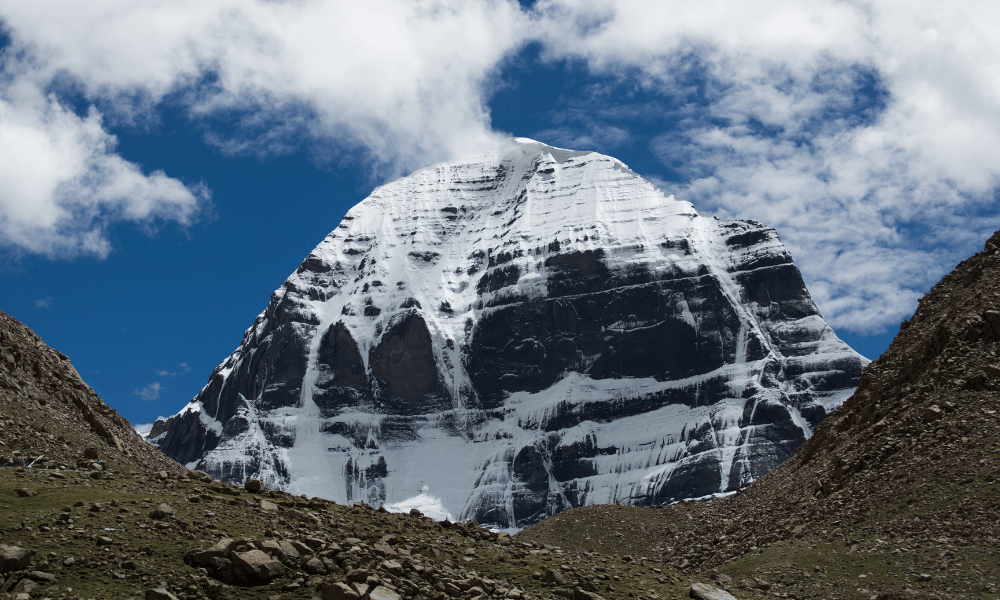Mount Kailash and Lake Mansarovar, located in an enigmatic Tibetan expanse, beckon with a magnetic pull that transcends the borders of spirituality and adventure. Mount Kailash, which stands at an awe-inspiring elevation of 21,778 feet (6,638 meters), is a tribute to nature's grandeur and cultural significance. The pristine waters of Lake Mansarovar reflect the mountain's magnificent majesty, mirroring the sky and surrounding peaks in its flawless embrace. Together, they create a pilgrimage destination treasured by many religions, creating a spell on spiritual seekers and trekkers all over the world.
Kailash Mansarovar's spiritual significance is intimately intertwined into the complex fabric of religious beliefs. Mount Kailash is revered as Lord Shiva's abode, a major deity in Hinduism, with the Kailash Parikrama, or circumambulation of the mountain, having enormous religious significance. The sacred attraction is enhanced by Lake Mansarovar, which is considered the creation of Brahma, the Hindu deity of creation. Buddhists revere Kailash as the home of Demchok, the embodiment of supreme bliss. The combination of religious sanctity gave rise to the Kailash Mansarovar Yatra, a pilgrimage of exceptional spiritual significance that draws pilgrims from all over the world.
The Kailash Mansarovar Yatra has grown in popularity in recent years, grabbing the hearts not only of religious pilgrims but also of adventure seekers looking to push their physical and mental limits. The temptation of attempting a challenging trek around Mount Kailash, with its harsh terrains and steep heights, has piqued the interest of people seeking a physical and spiritual voyage. The Yatra's growing popularity has transformed it into a one-of-a-kind blend of devotion and adrenaline, where participants not only seek blessings but also push personal boundaries against the stunning Himalayan scenery. This magnetic pull has made Kailash Mansarovar a well-known destination, enticing visitors to embark on a journey that promises not just breathtaking sights but also a profound connection with the divine.
Related Article: Kailash Parvat Photos
List of Things You Must Know Before
-
Significance
-
Major Attractions
-
Visa, Permits and Documentations
-
How to reach
-
Best Time To Visit
-
Packing Essentials
-
Health and Insurance
-
Challenges and Physical Fitness
-
Food and Accommodations
-
Communication and Currency
Kailash Yatra Significance
The Kailash Mansarovar Yatra is more than just a physical excursion; it is a religious pilgrimage. Set against the beautiful Himalayan background, it carries significant spiritual importance. This journey to Mount Kailash and Mansarovar Lake is more than just a journey; it is a transforming experience that is believed to purify the soul and lead to spiritual enlightenment. Here are the religions that consider the yatra sacred, as well as the reasons why.
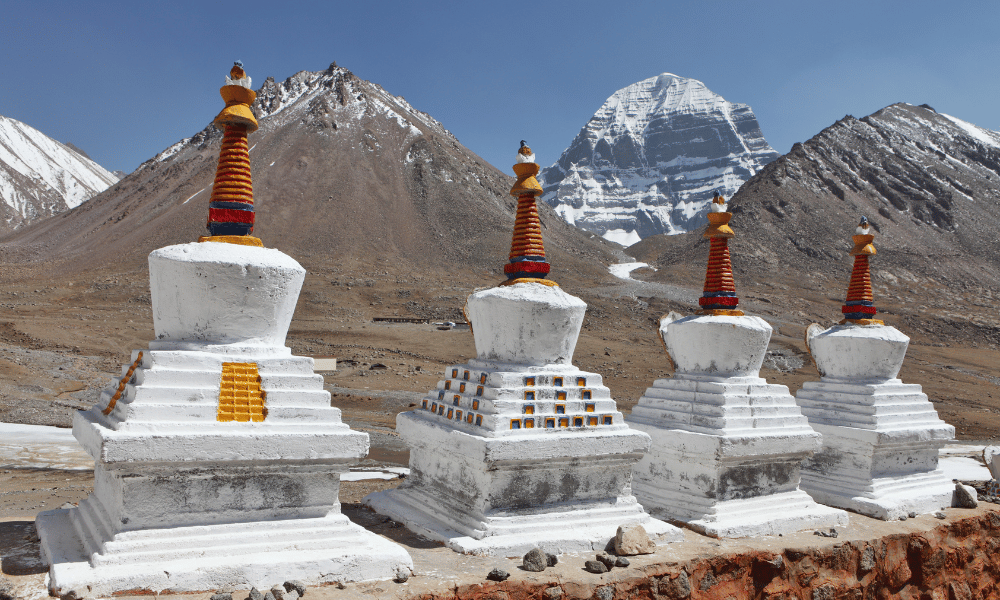
Hinduism
For Hindus, Kailash Mansarovar holds unparalleled significance as the abode of Lord Shiva, the destroyer and transformer in the Holy Trinity of Brahma, Vishnu, and Maheshwara (Shiva). Mount Kailash is believed to be the cosmic center of the universe, and circumambulating it, known as the Kailash Parikrama, is considered a sacred act that purifies the soul. The Mansarovar Lake is considered to be a repository of spiritual energy, and its waters are believed to have the power to cleanse sins and grant moksha, the liberation from the cycle of rebirth.
Buddhism
Tibetan Buddhists regard Mount Kailash as the home of the Cakrasamvara Buddha which is also known as Demchok. They believe circumambulating the mountain helps in attaining enlightenment. In Buddhism, Mount Kailash is associated with Guru Rinpoche, also known as Padmasambhava, who is credited with introducing Buddhism to Tibet. The circumambulation of Kailash is considered a transformative journey, symbolizing the practitioner's progress on the path to enlightenment. The region around Kailash is also believed to be the residence of deities and a place where great sages meditate, making it a sacred pilgrimage site for Buddhists seeking spiritual elevation and insight.
Jainism
Jains consider Mount Kailash to be the site where the first Jain Tirthankara, Rishabhanatha, achieved liberation from the cycle of rebirth and death. It is believed that Rishabhadeva attained spiritual liberation on the slopes of Mount Kailash. For Jains, Kailash holds historical and spiritual significance, and the yatra to this sacred site is seen as an opportunity to connect with the spiritual heritage of their tradition.
Bon
For followers of Bon, the indigenous religion of Tibet, Kailash is believed to be the sacred nine-story Swastika Mountain that leads to the heavens. The Bon religion, which predates Buddhism in the Tibetan region, also recognizes the sanctity of Kailash Mansarovar. In Bon tradition, Kailash is known as the "Nine-Story Swastika Mountain," and it is considered the seat of spiritual power and the dwelling place of the gods. The circumambulation of Kailash is regarded as a sacred ritual to attain spiritual merit and enlightenment in Bon practices.
Completing the Kailash Mansarovar Yatra is not merely a test of physical endurance but also a journey of spiritual transformation. It is regarded as one of the most sacred and challenging pilgrimages in the world. Pilgrims return from the journey often describing a sense of spiritual awakening, renewal, and a deeper understanding of their faith.
Major Attractions of Kailash Yatra
Taking the Kailash Mansarovar Yatra reveals a journey filled with key attractions that combine natural wonders and spiritual importance. From Mount Kailash to the tranquil Mansarovar Lake, each stop along the road, including Yam Dwar, Gauri Kund, and Om Parvat, has its own appeal and spiritual resonance. This pilgrimage is a captivating journey that draws devotees and travelers alike into a tapestry of holiness and spirituality as they uncover the extraordinary secrets of Kailash Mansarovar. Here are some of the most significant stops along the way:
Mount Kailash

Mount Kailash, nestled amid the beautiful vistas of the Himalayas, is an awe-inspiring tribute to nature's grandeur. Its towering snow-capped summits and unusual pyramidal shape, revered by numerous religious faiths, offer a stunning panorama that captivates pilgrims and adventurers alike. Mount Kailash's beauty attracts visitors from all over the world on the Kailash Mansarovar Yatra. Pilgrims doing the sacred circumambulation are immersed not only in spiritual significance, but also in the tranquil beauty of one of the world's most spectacular peaks, creating an unforgettable and spiritually uplifting experience.
Learn More: Mount Kailash
Mansarovar Lake

The mystical Mansarovar Lake, set against the background of the majestic Mount Kailash, is at the heart of the Kailash Mansarovar Yatra. Its calm, clear waters reflect the majesty of the surrounding peaks, providing a peaceful and religious atmosphere. Pilgrims on this spiritual journey are lured to the shores of Mansarovar to undertake rituals in search of spiritual purification in its heavenly waters. As the sun sets, giving a golden glow on the lake, Mansarovar transforms into more than just a destination, becoming a fascinating and beautiful highlight of the Kailash Mansarovar Yatra.
Learn More: Lake Mansarovar
Yam Dwar
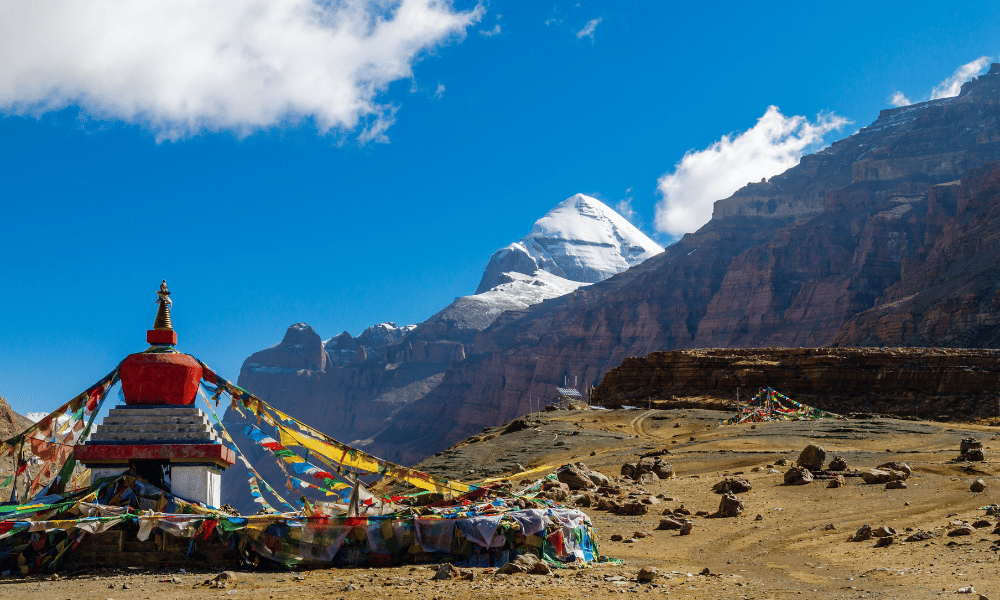
On the Kailash Mansarovar Yatra, Yam Dwar, popularly known as the "Gateway of the God of Death," has a special significance. It is located on the way to Mount Kailash and serves as the starting point for the sacred pilgrimage. Passing through Yam Dwar, pilgrims believe, represents leaving behind worldly bonds and entering the holy realm. This spiritually charged place serves as a powerful symbol of the yatra transforming character, making it a major and symbolic draw for people embarking on the sacred journey to Kailash Mansarovar.
Gauri Kund
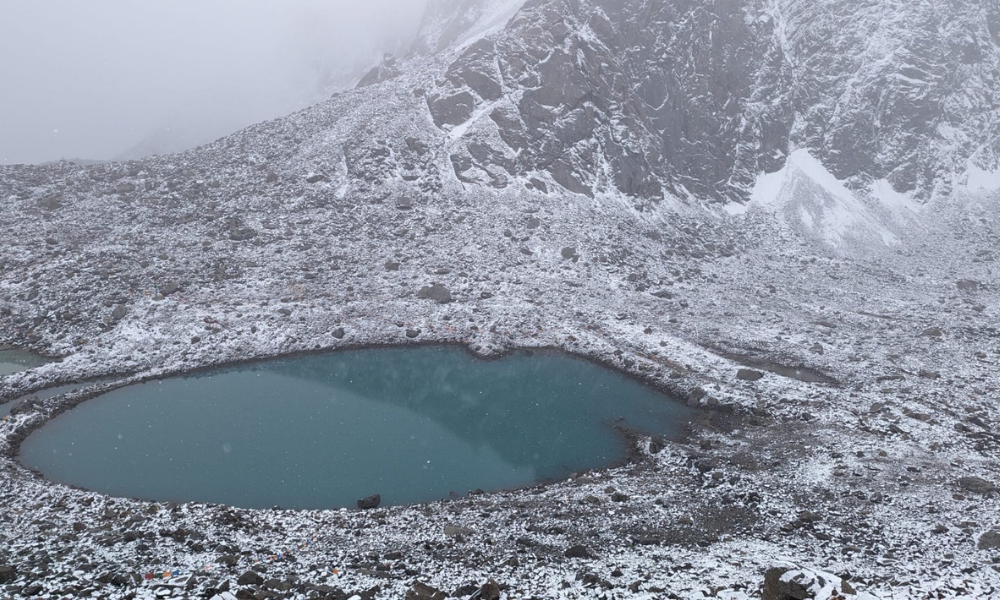
On the Kailash Mansarovar Yatra, Gauri Kund, a pristine high-altitude lake, appears as a sacred sanctuary. It is named after the Goddess Parvati (Gauri) and has significant spiritual significance. Pilgrims see the waters of Gauri Kund as auspicious and frequently indulge in traditional cleansing before embarking on the difficult journey. Surrounded by incredible landscapes, Gauri Kund serves as a serene stop on the pilgrimage, offering a moment of reflection and spiritual renewal amidst the hard terrains, making it a major attraction for Kailash Mansarovar Yatra seekers.
Rakshas Tal
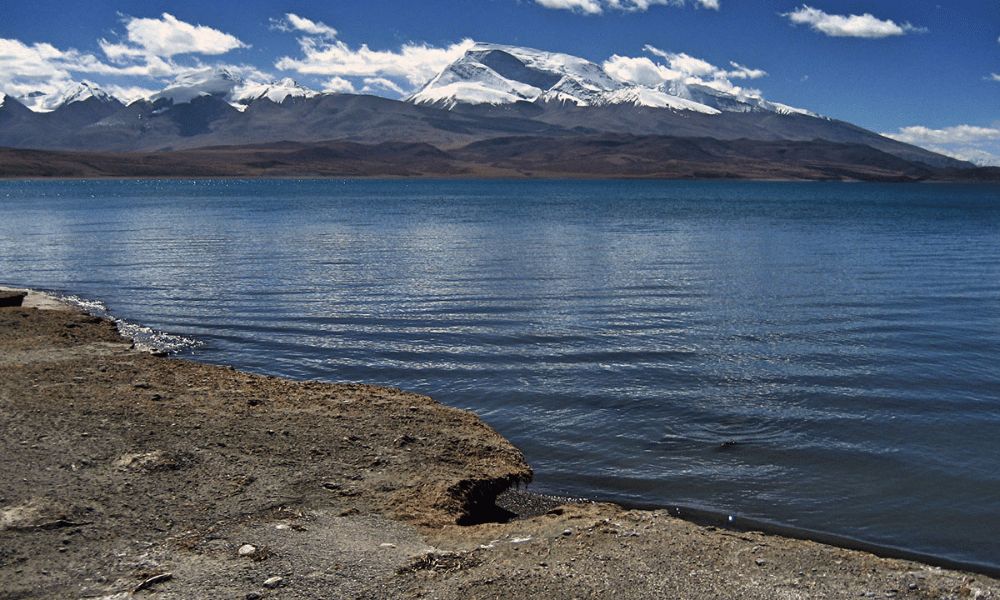
Pilgrims traveling the sacred routes of the Kailash Mansarovar Yatra come to the intriguing Rakshas Tal, also known as the Demon's Lake. This mystical water feature, nestled in the shadow of Mount Kailash, is steeped in ancient tradition and stories. Its dark, reflected waters provide a sense of mystery to the voyage, enticing pilgrims with its one-of-a-kind ambiance. Rakshas Tal is a prominent attraction along the yatra, providing not only a gorgeous break but also an opportunity to reflect on the mystical qualities of the sacred pilgrimage.
Om Parvat

Om Parvat, which stands at 5,590 meters, captivates travelers with its unique feature—an intricately inscribed 'Om' symbol on its rocky surface. This sacred marking, a rare and natural phenomenon, adds to the pilgrimage route's spiritual value, making Om Parvat a key attraction. Om Parvat is a beautiful and awe-inspiring monument to the mystical allure of Kailash Mansarovar Yatra, thanks to its lofty location, towering height, and the presence of this holy inscription.
Nandi Parvat
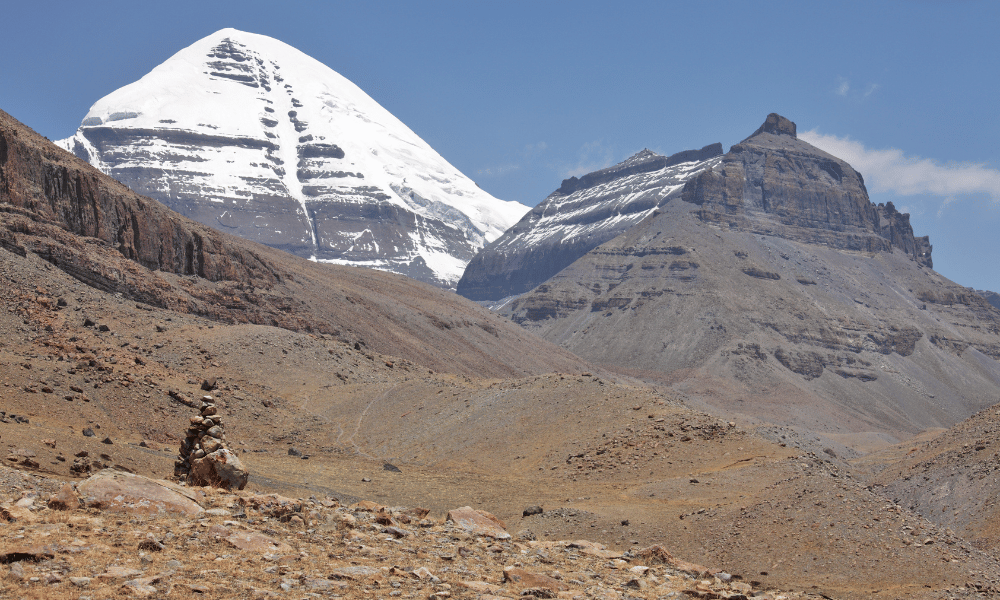
Nandi Parvat, the gatekeeper of the sacred route leading to Mount Kailash's divine realm, has a remarkable similarity to Lord Shiva's celestial vehicle, Nandi. This towering mountain commands attention with its awe-inspiring presence as a silent witness to the spiritual voyage of the Kailash Mansarovar Yatra. Nandi Parvat serves as a symbol of calm majesty, encouraging pilgrims along the road. Its imposing stature serves as a source of both reflection and inspiration, adding a depth of reverence to the spiritual trek to Kailash Mansarovar. Pilgrims are intrigued by a prominent landmark in the calm magnificence of Nandi Parvat, which adds a profound dimension to their sacred trek.
Chiu Monastery
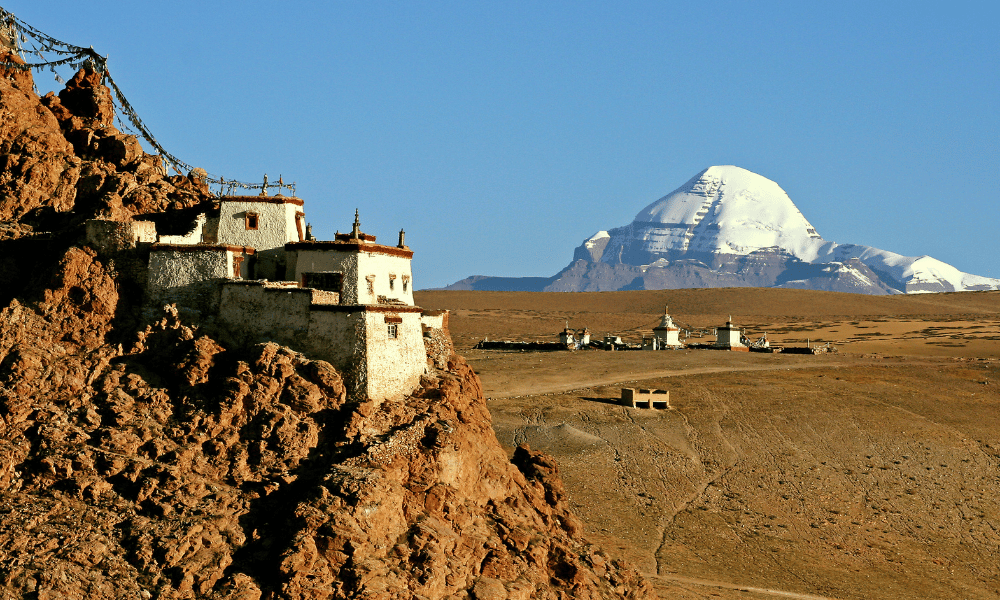
Chiu Monastery, nestled against the Himalayas, emerges as a tranquil retreat and a prominent attraction on the Kailash Mansarovar Yatra. This historic monastery, located near the sacred Lake Mansarovar, breathes spiritual tranquility. Pilgrims are drawn to it because of its ageless beauty and distinctive Tibetan architecture. Chiu Monastery, as a place of refuge and devotion, offers an opportunity for spiritual reflection, boosting the transforming experience of the sacred trip to Kailash Mansarovar.
Dirapuk Monastery
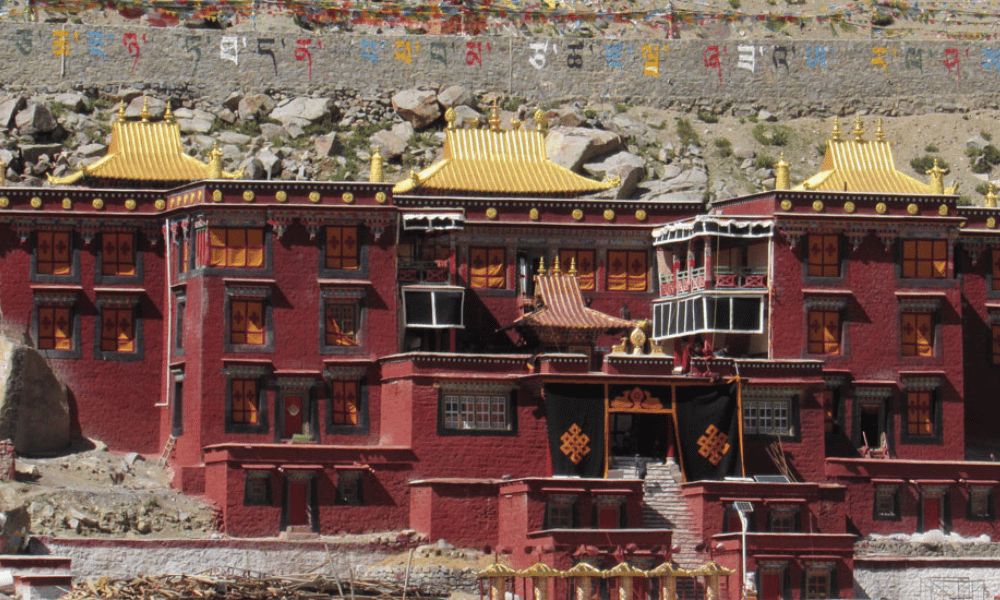
Dirapuk Monastery, located at the northern base of Mount Kailash, serves as a spiritual sanctuary and a prominent destination on the Kailash Mansarovar Yatra. The monastery, surrounded by breathtaking mountain views, provides pilgrims with a place for contemplation and devotion. Its traditional Tibetan architecture and calm ambiance create a spiritual aura, making it an important pilgrimage stop. Pilgrims find consolation in the spiritual aura that surrounds Dirapuk Monastery, giving their journey to the hallowed Mount Kailash new significance.
Ashtapad
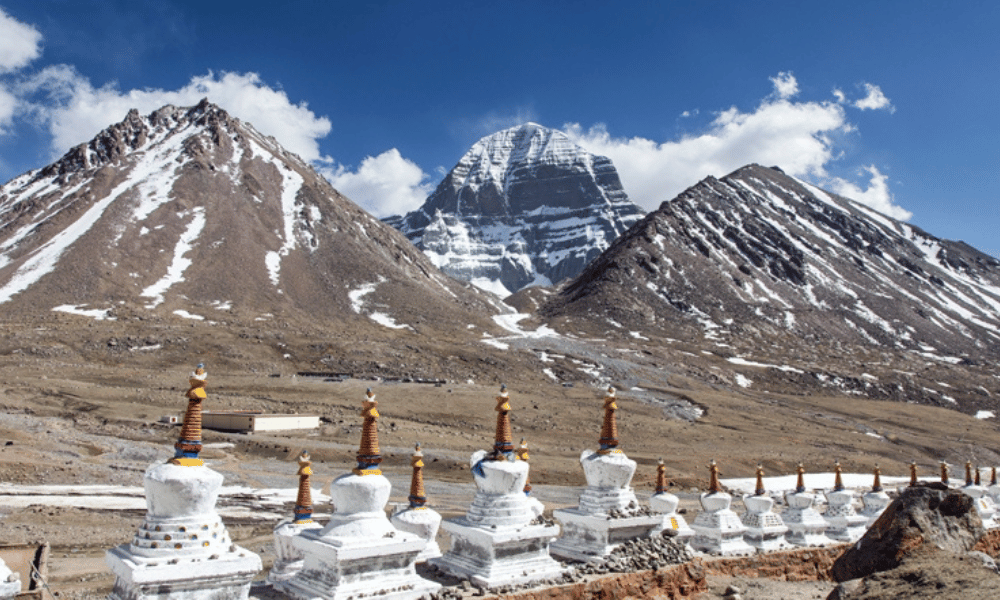
Ashtapad, a high-altitude alpine plateau, is a celestial jewel and a key attraction on the Kailash Mansarovar Yatra. It is located near Mount Kailash and provides travelers with a stunning panoramic view of the sacred mountain. Pilgrims and trekkers alike are drawn to Ashtapad's mysterious appeal and spiritual atmosphere. As guests immerse themselves in the spectacular sceneries and spiritual energy that define Ashtapad along the sacred trail, the trek to this celestial destination adds a sense of wonder and devotion to the yatra.
Charan Sparsh
Charan Sparsh, a sacred location on the Kailash Mansarovar Yatra, carries great importance as pilgrims reach out to touch the divine. It is situated at the foot of Mount Kailash and is a symbolic act of reverence and surrender to the spiritual journey. Pilgrims seek blessings by touching the sacred ground and connecting with the energy that flows through the area. Charan Sparsh transforms into a dramatic moment, fusing spirituality and devotion, becoming an important and spiritually nourishing attraction on the sacred road to Kailash Mansarovar.
Also Read: What is Kailash Mansarovar Yatra?
Visa, Permits and Documentations
Traveling to Kailash Mansarovar involves careful consideration of visas, permits, and other necessary papers. These vital components serve as the entrance to the holy vistas of Mount Kailash and Mansarovar Lake. Understanding and obtaining the proper permits and visas are critical stages in ensuring an enjoyable trip. Let's look at the important aspects that lead to this profound spiritual journey.

Visas
There are 2 visas required for the Kailash Mansarovar Yatra from Nepal. Here are the required visas and ways you can get them:
Nepalese Visa
Except for Indians (For more information please visit Nepal government's official website), all foreign nationals, including NRIs, require visas to enter Nepal. Multiple entry visas are available from any Nepalese embassy or consulate. You can also obtain a visa on arrival at the Tribhuvan International Airport in Kathmandu or at the Immigration Offices located at Nepal's entry ports. Here is a list of on-arrival multiple entry visa fees in Nepal:
|
Duration |
Cost |
|
15 Days |
USD 30 |
|
30 Days |
USD 50 |
|
90 Days |
USD 125 |
Tourist visas can be extended for a minimum 15 days with USD 45 and USD 3 per day for additional days at the Immigration Department in Kathmandu and Pokhara Immigration Office. However, nationals of the following countries will not get a visa on arrival at the immigration entry points of Nepal: Afghanistan, Cameroon, Ethiopia, Ghana, Iraq, Liberia, Nigeria, Palestine, Somalia, Swaziland and Zimbabwe. They need to obtain visas from Nepalese embassies or diplomatic missions in their respective countries prior to their arrival in Nepal.
Gratis (Free) Visa for 30 days is available only for nationals of SAARC countries(except Afghanistan) like Bangladesh, Bhutan, Maldives, Pakistan and Sri Lanka for the first visit in a given year. Chinese Nationals are given a Gratis visa for 150 days. You can contact us for more information regarding visa and permit procedures.
For an online visa application click here. You will find information to get the Nepal visa online.
Group Tourist Visa
If you are planning for Kailash Mansarovar Yatra, we arrange everything you need as we hold the liability to arrange everything including visas and permits to visit Kailash Mansarovar. The visa to Tibet is accessible from the Chinese Embassy in Kathmandu. It takes at least 3-4 working days to obtain a visa for Tibet to visit Kailash Mansarovar. So please arrive in Nepal with enough window for the Visa process. For Foreign nationals and NRIs, a valid passport and visa, and a Kailash permit is mandatory to visit Kailash Mansarovar.
Permits
Obtaining the proper permits is an important part of planning a pilgrimage to Kailash Mansarovar. The China-issued permit is required for entry into the Tibetan Autonomous Region, which includes Mount Kailash. Here is information about the requisite permit and how to obtain it:
Tibet Travel Permit (TTP)
A Tibet Travel Permit, also known as a Tibet Visa or a Tibet Entry Permit, is required for international travelers to enter Tibet in addition to a Chinese visa. It is an official travel document issued by the Tibet Tourism Bureau. Your tour group number, tour date, daily itinerary, and tour operator are all mentioned on this paper. A Tibet Permit is required for all international visitors in order to board a flight or train going for Lhasa. It is available through authorized tour operators such as us. Permits are handled by the Ministry of External Affairs for Indian pilgrims.
Documentations Required
The sacred trek to Kailash Mansarovar requires careful planning, and ensuring you have the proper documents is a key component of the preparatory process. The legal requirements for the Kailash Mansarovar Yatra may vary, but the following list provides a full overview of the necessary documents:
Passport
A valid passport is the primary form of identification necessary for international travel and is required for the Kailash Mansarovar Yatra. Make sure your passport is valid for at least six months beyond your scheduled return date.
Travel Insurance
It is strongly advised and required to have appropriate travel insurance covering the Kailash region. Our trip packages do not include the cost of travel insurance, and it is the pilgrim/traveler's own responsibility to ensure that he or she is appropriately covered for the duration of the journey. Furthermore, having travel insurance becomes mandatory as you will be climbing up to 5000 meters, which is extremely high for normal individuals. As a result, having travel insurance that includes emergency helicopter rescue is critical. If you do not have one and require assistance, we are always willing to assist you in obtaining yatra-appropriate insurance.
Passport Photocopy Front and Back
Your need to keep multiple copies of your passport, since it can be asked at various points of your yatra.
Photo: Passport Size (recent)
Carry several passport-sized photographs, as these are often required for various permits and visas.
Medical Certificate
It is not a compulsion for a medical certificate but we recommend visitors to do a proper medical checkup and get approval from medical professionals for the yatra. Ensuring your medical fitness for the yatra will help you greatly in the yatra.
Application Form
To participate in the sacred Kailash Mansarovar Yatra, you have to fill out an application form with your personal information, emergency contacts, health information, and travel preferences. By completing this form, you acknowledge the pilgrimage's challenges and confirm your physical fitness for the trek. You also agree to relieve the organizers from any liability resulting from unforeseeable incidents. Read and comprehend the terms and conditions, which encompass itinerary adjustments and more.
Learn More: Kailash Yatra Information For NRIs
How to Reach Kailash Mansarovar
The sacred journey to Kailash Mansarovar is a pilgrimage rich in spiritual meaning and breathtaking natural beauty. Getting to this sacred site requires a combination of scenic trekking and smart trip planning. Understanding the routes and forms of transportation becomes the first step in unlocking the gates to this heavenly journey, providing a flawless and spiritually enlightening adventure as pilgrims set their sights on the beautiful heights of the Himalayas and the serene shores of Mansarovar Lake. Here, we explore the numerous routes and travel alternatives pilgrims might take to visit Kailash Mansarovar, assuring a smooth and spiritually enlightening journey.
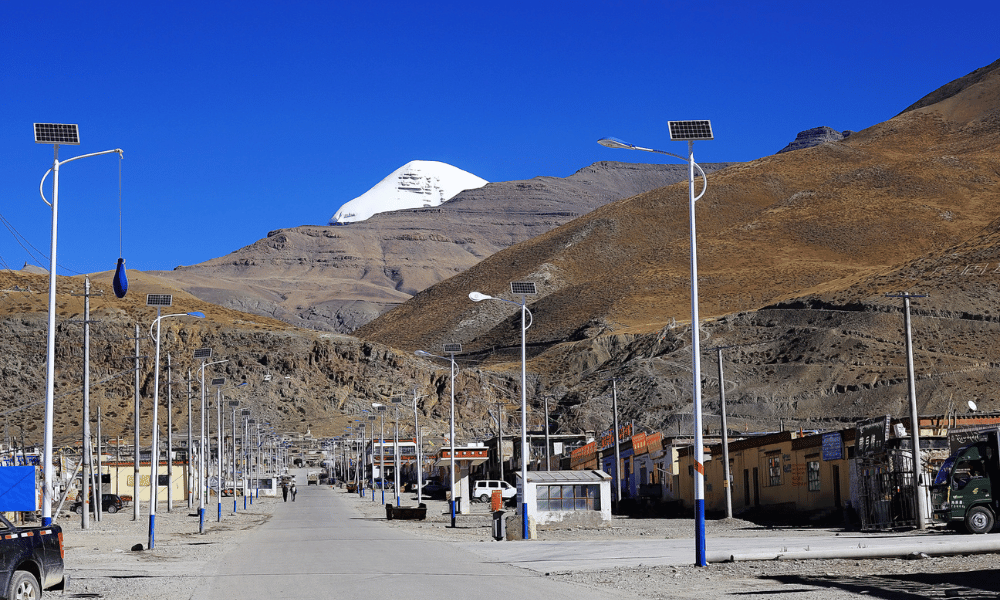
Kailash Mansarovar Yatra by Helicopter (Via Hilsa Border)
The Kailash Mansarovar Yatra by helicopter is a spiritual trip package that allows you to visit Mt. Kailash and the sacred lake Mansarovar. This is a simpler and faster approach to completing the tour. It is advised for elders and physically weak persons to avoid the harsh terrain of the Kailash Mansarovar Yatra. The helicopter journey covers the distance from Nepalgunj to Hilsa, followed by a drive to Manasarovar. We’ve various handpicked dates for 2024 and are open for booking.
To book the Kailash Yatra dates, let us know your preferred dates and months and we’ll help you with further process.
|
Itinerary of Kailash Mansarovar Yatra by Helicopter |
|
Day 01: Arrive in Kathmandu. (1400m) |
|
Day 02: Kathmandu Sightseeing, Visa Application. |
|
Day 03: Bhaktapur Sightseeing. |
|
Day 04: Chandragiri Sightseeing. |
|
Day 05: Packing, Fly to Nepalgunj. |
|
Day 06: Fly from Nepalgunj to Simikot. (2910m) |
|
Day 07: Simikot - Hilsa - Taklakot. (4025 m) |
|
Day 08: At Taklakot – Rest Day Full Day – Free for Acclimatization. |
|
Day 09: Drive from Taklakot to Lake Mansarovar. (4550m) |
|
Day 10: Drive to Yama Dwara Trek to Dirapuk. (4909m) |
|
Day 11: Trek to Zuthulpuk. (4820 m) 4760 m) |
|
Day 12: Zuthulpuk to Hilsa or Simikot. |
|
Day 13: Hilas to Simikot, Fly back to Kathmandu Via Nepalgunj |
|
Day 14: Transfer to Airport. |
Learn More: Kailash Mansarovar Yatra By Helicopter
Kailash Mansarovar Yatra by Road (Via Kyirong Border)
Kailash Mansarovar Yatra is a wonderful journey from the holy abode of Shiva to Tibet. The Kailash Mansarovar Yatra has restarted in 2023, following a worldwide epidemic in 2020. The path via Kyirong, a charming border town in Tibet, not only allows visitors to immerse themselves in the transcendent grandeur of the Himalayas, but also allows them to connect more deeply with the spiritual energy that pervades this place.
We’ve published our fixed departure dates for Kailash Yatra in 2024. If you are planning to join Kailash yatra, let us know your requirements and we’ll assist you with the process.
|
Itinerary of Kailash Mansarovar Yatra by Road |
|
Day 01: Kathmandu Arrival. |
|
Day 02: Kathmandu Sightseeing, Visa Application. |
|
Day 03: Bhaktapur Sightseeing. |
|
Day 04: Chandragiri Sightseeing. |
|
Day 05: Packing and Final Preparation. |
|
Day 06: Drive from Kathmandu to Dhunche or Syabrubesi or Timure. |
|
Day 07: Drive to Kyirong. (2850 m) |
|
Day 08: Drive to Saga. (4550m) |
|
Day 09: Drive from Saga to Lake Mansarovar. (4550m) |
|
Day 10: Drive to Darchen. (4650 m) - 35 KM |
| Day 11: Drive to Yama Dwar, Trek to Dirapuk. (4909 m) - 12 KM |
|
Day 12: Trek to Zuthulpuk. (4820 m) (4760 m) (22 KM) |
|
Day 13: Zuthulpuk to Saga. (8 KM Trek and 470 KM Drive - 8 hrs) |
|
Day 14: Drive back to Kyirong. (2850M) |
|
Day 15: Drive to Kathmandu. (1400m) |
|
Day 16: Departure. |
Learn More: Kailash Mansarovar Yatra By Drive (Via Kyirong)
Kailash Mansarovar Yatra Via Lhasa
Kailash Mansarovar Yatra via Lhasa is another popular way to complete Kailash Yatra. The Kailash Journey is one of the most awaited religious journeys which was postponed because of the pandemic. The only international flight to Tibet which is from Kathmandu has yet to come into operation since the pandemic.
The Yatra to Kailash Mansarovar via Lhasa in 2024 is anticipated to be open soon. So, if you are planning to visit Kailash, let us know your requirements and we’ll further process your booking. The itinerary for Kailash Yatra via Lhasa is provided below.
|
Itinerary of Kailash Mansarovar Yatra Via Lhasa |
|
Day 01: Arrive in Kathmandu. |
|
Day 02: Kathmandu Sightseeing. |
|
Day 03: Chandragiri and Patan Sightseeing. |
|
Day 04: Kathmandu Full Day Sightseeing. |
|
Day 05: Arrival in Lhasa, Lhasa Sightseeing. |
|
Day 06: Driving to Shigatse. |
|
Day 07: Shigatse to Saga. |
|
Day 08: Saga to Darchen, via Lake Mansarovar (450 km). |
|
Day 09: Darchen-Dirapuk (Trek 22 km). |
|
Day 10: Dirapuk to Zuthulpuk (Trek 18 km). |
|
Day 11: Zuthulpuk to Darchen (Trek 12 km). |
|
Day 12: Darchen to Manasarovar (60 km). |
|
Day 13: Lake Manasarovar to Saga. |
|
Day 14: Drive from Saga to Shigatse (470 km). |
|
Day 15: Drive from Shigatse to Lhasa (280 km). |
|
Day 16: Fly from Lhasa to Kathmandu. |
|
Day 17: Departure. |
Best Time To Visit
The best time to undertake the Kailash Mansarovar Yatra is during the months of May to September. This period aligns with the warmer months of late spring, summer, and early autumn, offering the most favorable weather conditions for the pilgrimage. During these months, temperatures are relatively milder, ranging from 15°C to 20°C (59°F to 68°F), facilitating a more comfortable trekking experience. Here's a more in-depth breakdown:
May to June: The weather begins to warm up, providing bright sky and comfortable temperatures. The roads are reasonably clear of snow, providing for a smoother and safer travel. The region's natural beauty is at its optimum, with lush vistas and beautiful flowers along the way.
July to August: These are the busiest months for the yatra. The weather is pleasant, and the days are long, allowing for easy travel and plenty of time to explore the spiritual and natural sights along the way. You can expect light rain during this period of time.
September: As the area transforms into fall, September is an excellent time to go on the yatra. The weather is still beautiful, with less rain than in the summer. The beautiful sky provides breathtaking views of Mount Kailash and the surrounding countryside.
Pilgrims are advised to plan their journey within this window to maximize the chances of a smooth and spiritually enriching experience amidst the breathtaking landscapes of Kailash Mansarovar. It is important to note that the yatra is often avoided during the winter months (October to April) because of extreme weather conditions such as heavy snowfall and cold temperatures, which can cause road closures and make the trek dangerous.
Read More: Best Time To Visit Kailash Mansarovar
Packing Essentials
Embarking on the sacred Kailash Mansarovar Yatra requires thoughtful packing to ensure comfort, safety, and preparedness for the diverse challenges of the journey. The weather conditions along the Kailash Mansarovar Yatra route vary significantly, presenting pilgrims with diverse climates ranging from mild temperatures in lower altitudes to chilly conditions at higher elevations. During the ideal pilgrimage months from May to September, pilgrims can expect daytime temperatures between 15°C to 20°C (59°F to 68°F), but evenings and mornings may be colder. As treks may involve traversing rugged terrains, layered clothing is essential, allowing pilgrims to adapt to fluctuating temperatures throughout the day.
Here is a comprehensive list of the packing essentials needed for your Kailash Mansarovar Yatra:
|
Clothing |
Essentials |
Additional |
|
Warm and Comfortable Clothes |
Soap and Shampoo |
Hiking Poles |
|
Hiking Boots and Sandals |
Toiletries |
Camera, Batteries, Binocular |
|
Shorts |
Dust Mask/Sanitizer |
Headlamp |
|
Trekking Pants |
Dry and Wet Tissues |
Small First Aid Kit |
|
Long Sleeved Shirt |
Quick-Dry Towel |
Documents (Passport, Permits, Visa) and Cash |
|
Fleece Jacket |
Sunglasses |
Water Bottle |
|
Rain Jacket |
Sunscreen/Sunblocks |
Plastic bags, Deo, Thread and Needle |
|
Fleece Jacket |
Moisturizers, Lip Balm |
Energizers, Chocolates |
|
Socks, Woollen Gloves |
Hat, Balaclava |
Snacks, Fruits |
|
Backpack |
Personal Medicine |
Worship Elements |
Learn More: Kailash Mansarovar Yatra Packing List
Health and Insurance
Due to the particular challenges provided by the rough terrain and high elevations, embarking on the sacred trip of the Kailash Mansarovar Yatra necessitates careful consideration of health and insurance issues. Physical fitness, including cardiovascular exercise, weight training, and altitude simulation, is essential. Pilgrims should be aware of the risks connected with high altitudes, such as altitude sickness, and adopt preventive measures such as acclimatization periods and remaining well hydrated.

Health Precaution For Kailash Mansarovar Yatra
Pre-Travel Health Check:
The Kailash Mansarovar Yatra necessitates peak physical condition. Prior to embarking on the adventure, it is critical to speak with healthcare professionals who can evaluate general fitness and obtain medical clearance. This is especially important for people who have pre-existing diseases like asthma. A thorough health examination ensures that pilgrims are physically and mentally prepared for the journey.
Carry Necessary Medications:
Individuals with asthma or other pre-existing health disorders must carry appropriate medications at all times. Asthmatic patients, in particular, should have an appropriate supply of prescribed inhalers and drugs to effectively treat any respiratory issues that may emerge during the voyage.
Emergency Evacuation Plan:
Due to the pilgrimage's remote and difficult terrain, it is important to have a clear plan for how to get out of the area in case of an accident. Pilgrims should become acquainted with the methods indicated by tour organizers, ensuring easy access to emergency contact information. This proactive strategy is crucial for dealing with unexpected health concerns as soon as possible.
Altitude Sickness Preparedness:
The journey involves traveling at high altitudes, which raises the possibility of altitude sickness. To reduce this risk, gradual acclimatization is essential. Pilgrims should gradually ascend, allowing their bodies to adjust. Understanding altitude sickness symptoms and taking proper precautions, such as descending if necessary, are critical components of readiness.
Learn More: Altitude Sickness
Asthma Patient:
High elevations of 15,000 to 19,000 feet can have an impact on respiratory function, potentially inducing asthma symptoms. Before embarking on this trek, asthma patients should check with their doctors. Acclimatization, moderate elevation, and carrying prescribed medications are all required. The difficult hike and changing weather conditions necessitate cautious planning. Despite the hurdles, patients with asthma can still participate in this spiritual adventure with proper medical care and measures, assuring a safe and meaningful Kailash Mansarovar Yatra experience.
Consult with Tour Organizers:
Open communication with tour organizers is essential for providing a customized support system. Pilgrims, particularly those with pre-existing medical issues, should communicate any health concerns to the organizers. Because of this transparency, organizers are able to provide the required assistance and support.
Insurance Guidelines for Kailash Mansarovar Yatra:
Comprehensive Travel Insurance:
It is critical to purchase adequate travel insurance. The strategy should expressly contain procedures for high-altitude trekking in addition to medical crises and evacuation. Pilgrims should thoroughly study the terms, ensuring that coverage limits and exclusions are clearly defined.
Emergency Evacuation Coverage:
Emergency evacuation coverage is of the utmost importance, given the pilgrimage's involvement with remote locations. Pilgrims must ensure that the insurance policy includes provisions for quick and effective emergency evacuations.
Read Policy Terms:
Understanding the terms of the insurance policy is essential for informed decision-making during emergencies. Pilgrims should conduct a detailed review, familiarizing themselves with coverage details, limitations, and exclusions.
Policy Recognition in Tibet and Nepal:
Ensuring that the insurance policy is recognized and accepted in the regions traversed during the pilgrimage is vital. Pilgrims should verify that the policy aligns with local requirements and regulations.
With these precautions in place, pilgrims can not only improve their safety and well-being, but also thoroughly immerse themselves in the spiritual significance of the Kailash Mansarovar Yatra.
Challenges and Physical Fitness
The Kailash Mansarovar Yatra poses a variety of hurdles, highlighting the significance of physical fitness for a safe and rewarding journey. The rough terrain, high altitudes, and variable climatic conditions need pilgrims being mentally and physically prepared.
Altitude Challenges
Ascending to the Himalayan peaks carries the danger of altitude-related difficulties. Altitude sickness is a serious problem at high altitudes, and pilgrims may encounter symptoms such as headaches, nausea, and dizziness. Adequate acclimatization pauses, moderate elevation, and maintaining hydration are critical strategies for overcoming these difficulties. Physical fitness helps the body adapt to lower oxygen levels at higher elevations, improving its ability to deal with the demands of the journey.
Rigorous Terrain
The trekking routes around Mount Kailash feature a variety of terrains, from rocky slopes to steep ascents. Pilgrims must traverse difficult terrain that requires endurance, strength, and agility. Physical fitness is an important factor in successfully navigating these terrains, as it reduces the chance of injury and allows pilgrims to fully engage in the spiritual and cultural experiences along the journey.
Unpredictable Weather
The unpredictable Himalayan weather plays a major role in the Kailash Mansarovar Yatra. Pilgrims traveling this sacred road face rapid temperature variations from pleasant to extremely cold at higher altitudes. The rocky environment brings unexpected rain, snow, and intense sunlight, forcing pilgrims to adapt quickly. With temperatures fluctuating, it is critical to pack strategically, including layered clothing and waterproof items. Pilgrims have to embrace resilience, ready to confront the unpredictable elements as they embark on their spiritual trek through Kailash Mansarovar's breathtaking landscapes.
Endurance and Mental Resilience
The Kailash Mansarovar Yatra is a test of both physical and mental endurance. Pilgrims on this spiritual pilgrimage face difficult terrain and high altitudes, requiring inner strength to overcome exhaustion and sustain resilience. The contemplative components of the pilgrimage need mental strength when pilgrims confront moments of solitude. The fusion of physical as well as mental challenges along this sacred path becomes a transformative journey, molding pilgrims' endurance and perseverance amidst Kailash Mansarovar's breathtaking sceneries.
Food and Accommodation Challenges
Due to its remote and rough terrain, the Kailash Mansarovar Yatra presents food and accommodation issues. There are few dining options and minimal accommodations ranging from guesthouses to tented camping. Pilgrims are encouraged to be adaptive and flexible, recognizing the pilgrimage's emphasis on spiritual development over worldly comforts. Adequate preparation, including taking personal refreshments, aids in mitigating the challenges posed by the remote conditions encountered along the sacred trek.
A comprehensive strategy for physical fitness should be part of the planning process for the Kailash Mansarovar Yatra. Pilgrims are urged to improve their overall endurance by engaging in cardiovascular activities, weight training, and altitude simulation. Regular medical check-ups, immunizations, and consultation with healthcare specialists all help to ensure that persons are physically prepared to tackle the demands of this hallowed pilgrimage.
Food and Accommodations
The Kailash Mansarovar Yatra provides pilgrims starting on this sacred pilgrimage with a one-of-a-kind blend of food and accommodation. The journey to Kailash Mansarovar is both a spiritual pilgrimage and an expedition into the heart of the Himalayas, where food and shelter are critical considerations. Here's a taste of the culinary offerings and lodging options offered during this sacred yatra:

Food in Kailash Mansarovar Yatra
Your dining experience during the Kailash Mansarovar Yatra is directly linked to your location, indulging in a culinary voyage as diverse as the terrain itself. You'll enjoy the comfort of classic Indian meals on the Nepalese side, where culinary influences echo those of India. Once in Tibet, the culinary landscape alters, allowing you to sample authentic Tibetan food or choose other preferred options during your city stay, particularly during the critical acclimatization period. In the midst of difficult terrain and high altitudes, simplicity defines the culinary offers. Each day's food is based on Tibetan and Indian meals, and it serves as fuel for the strenuous hikes. You may be confident that a specialized cooking team will accompany you, ensuring freshly cooked daily meals. Given the spiritual significance of this site, the cuisine focus is primarily vegetarian, with an emphasis on easily digestible meals. Pilgrims are urged to pack portable refreshments such as energy bars and nuts to satisfy their dietary needs, enriching the overall experience of this hallowed yatra. The following is a list of some of the food options available during the parikrama:
|
Food Items Available During The Parikrama |
|
Rice |
|
Dal (Lentils Soup) |
|
Roti/Chapati (Flat Bread) |
|
Bread Jam |
|
Paratha |
|
Fruits |
|
Vegetable curries |
|
Tea and Coffee |
|
Noodles |
|
Pasta |
|
Cereals |
Accommodation During Kailash Mansarovar Yatra
The region has a variety of lodging alternatives, including hotels and guesthouses (dormitory) based on availability of the location one is in. Due to the remoteness, you will only find minimal accommodations from Deruphuk to Zuthulphuk with most basic facilities. Accommodations along the pilgrimage path fits with the overall theme of simplicity. Pilgrims find accommodation with modest amenities in basic guest houses tucked in the towns surrounding Mount Kailash or tented camps amidst nature's peacefulness. While the accommodations are basic, they provide a unique experience of staying in conjunction with the magnificent environment. Shared facilities are prevalent, emphasizing the pilgrimage's emphasis on spiritual exploration above lavish lodgings.
Practical considerations also play a role in keeping pilgrims going on their journey. Bringing snacks and dietary supplements guarantees a readily available source of nourishment, especially in remote regions with limited food options. Staying hydrated and eating carbohydrate-rich foods is critical in dealing with high-altitude circumstances. The basic accommodations give pilgrims with a room to recharge and reflect, reinforcing the pilgrimage's main focus on spiritual reflection and development. The Kailash Mansarovar Yatra evolves as a journey closely entwined with the pilgrims' physical and spiritual requirements in this blend of basic nutrition and shelter.
Communication and Currency
Traveling on the sacred Kailash Mansarovar Yatra entails crossing international borders and traversing numerous landscapes. Understanding the complexity of communication and currency becomes essential as pilgrims embark on this transforming journey. During their journey, pilgrims are provided with Nepalese and Chinese SIM cards for communication and internet facilities. Navigating communication facilities and currency variation is vital for a seamless pilgrimage experience, from Nepal's rich cultural tapestry to Tibet's distinct areas. Untangling the complexities of communication and currency offers insights that will enable pilgrims to interact with their loved ones and comfortably conduct financial transactions along the sacred journey to Kailash Mansarovar.
Communication Realities:
Intermittent Connectivity: Pilgrims should expect spotty mobile network service and limited internet access in the Himalayas' isolated terrains.
Informing Loved Ones: Due to potential communication gaps, it's crucial to inform family and friends about the journey's connectivity challenges beforehand.
Reliable Devices: Carrying essential communication devices like satellite phones becomes imperative to ensure a consistent means of staying connected, especially in isolated areas.
Currency Considerations:
Local Currencies: Transactions are primarily conducted in Nepalese Rupees (NRP) or Chinese Yuan (CNY), depending on the specific regions along the pilgrimage route.
|
Currency |
Exchange Rate to Chinese Yuan |
|
Indian Rupees (INR) |
1 INR = 0.086 CNY |
|
American Dollar (USD) |
1 USD = 7.14 CNY |
Note: Check the current exchange rate for more up-to-date information.
Cash Dependency: ATMs are infrequent, and credit card acceptance is limited, underscoring the necessity for pilgrims to carry ample cash for day-to-day transactions.
Strategic Planning: Pilgrims should plan ahead by exchanging currency before the journey, informing banks about travel plans, and carrying a mix of denominations for practicality.
Navigating Internet Restrictions:
App Restrictions: Certain Google and Facebook apps may face restrictions in Tibet, influenced by the Chinese government's control over internet access. However you can use VPN service to access those services.
Alternative Solutions: Pilgrims should be cognizant of these restrictions and explore alternative communication methods or apps such as whatsapp that are more widely accepted in the areas they will traverse.
Adaptability: Given the internet landscape's unique challenges, adaptability and resourcefulness become essential for effective communication throughout the pilgrimage.
The Kailash Mansarovar Yatra demands pilgrims handle not only the geographical and spiritual landscapes, but also the delicate realities of communication and currency in these remote and awe-inspiring terrains.
Conclusion
Taking the sacred pilgrimage to Kailash Mansarovar is a life-changing experience that necessitates both spiritual commitment and physical preparation. The ten key components outlined above serve as a guide for individuals who wish to embark on this celestial journey. Each insight, from knowing the region's significance across many religions to being well-versed in the problems of high elevations, contributes a critical piece of the puzzle.
Ensuring proper documentation, physical fitness, and health issues shows the pragmatic side of the trip, recognizing the difficult terrain and the need for resilience. Meanwhile, immersing oneself in the cultural tapestry, feeling the spiritual atmosphere at sacred locations, and adhering to local customs add layers of richness to the profound spiritual experience that is the Kailash Mansarovar Yatra.
May these ten insights serve as beacons, leading pilgrims through the intricate tapestry of this sacred trip, as they prepare to enter the magical regions of Mount Kailash and the serene shores of Lake Mansarovar. The Kailash Mansarovar Yatra promises an odyssey of the soul—one that transcends the physical and beckons pilgrims towards a higher realm of self-discovery and spiritual awakening—whether it's the awe-inspiring landscapes, diverse cultural encounters, or spiritual revelations along the path. May each step of this celestial journey bear witness to the great link that exists between the seeker and the divine.

